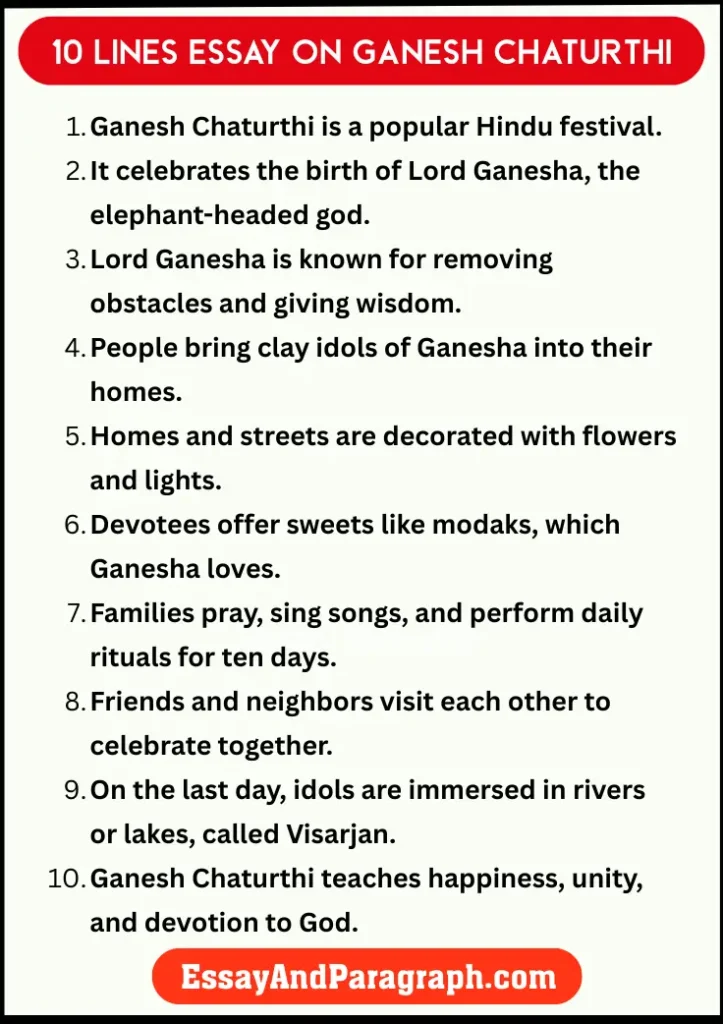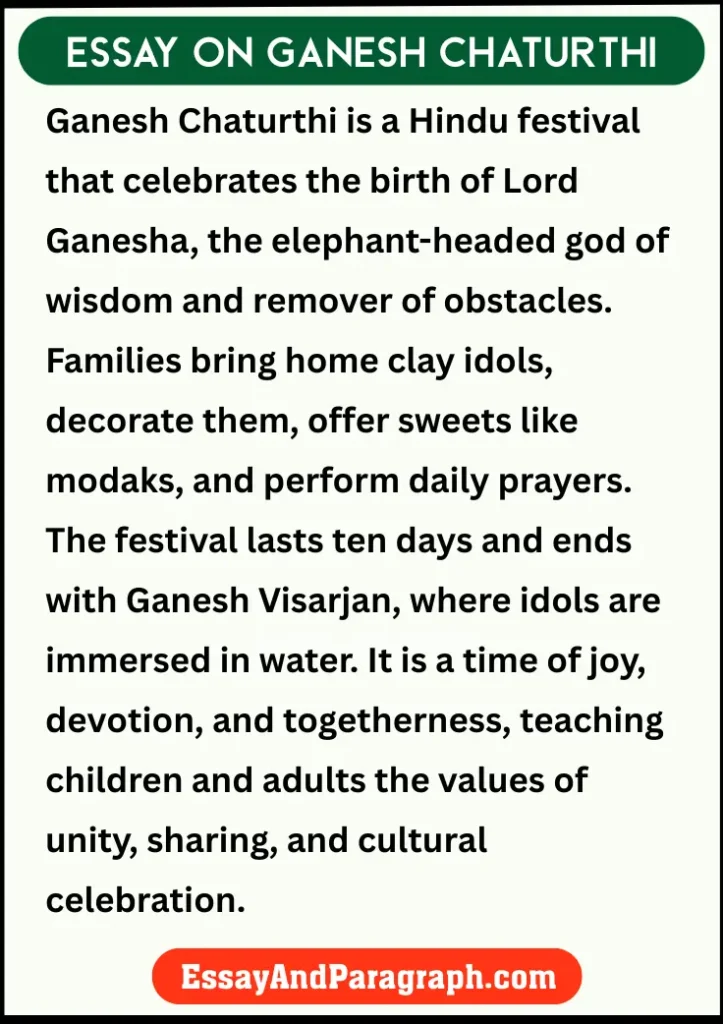Ever wondered how people celebrate one of India’s most joyful festivals? Ganesh Chaturthi is a special Hindu festival that honors the birth of Lord Ganesha, the elephant-headed god known for removing obstacles and bringing happiness. During this festival, families decorate their homes, bring home colorful idols of Ganesha, and share sweets like modaks. Friends and neighbors come together to sing, dance, and pray, creating a lively and joyful atmosphere. Celebrated across India, especially in Maharashtra, this festival brings communities closer and fills hearts with devotion and hope. In this article, we will learn how to write an essay on Ganesh Chaturthi, exploring its celebrations, rituals, and the joy it brings to everyone.
10 Lines Essay on Ganesh Chaturthi
Ganesh Chaturthi is a popular Hindu festival.
It celebrates the birth of Lord Ganesha, the elephant-headed god.
Lord Ganesha is known for removing obstacles and giving wisdom.
People bring clay idols of Ganesha into their homes.
Homes and streets are decorated with flowers and lights.
Devotees offer sweets like modaks, which Ganesha loves.
Families pray, sing songs, and perform daily rituals for ten days.
Friends and neighbors visit each other to celebrate together.
On the last day, idols are immersed in rivers or lakes, called Visarjan.
Ganesh Chaturthi teaches happiness, unity, and devotion to God.

Essay on Ganesh Chaturthi – 100 Words
Ganesh Chaturthi is a joyful Hindu festival that celebrates the birth of Lord Ganesha, the elephant-headed god of wisdom and new beginnings. Families bring home clay idols of Ganesha and decorate them with flowers and lights. For ten days, they offer prayers, sing songs, and share sweets like modaks, which Ganesha loves. On the last day, the idols are taken in a lively procession to be immersed in water, symbolizing Ganesha’s return to his heavenly abode. This festival brings communities together, spreading happiness and hope for the future.
Essay on Ganesh Chaturthi – 150 Words
Ganesh Chaturthi is a joyful Hindu festival that celebrates the birth of Lord Ganesha, the elephant-headed god who removes obstacles and brings wisdom. People across India, especially in Maharashtra, celebrate this festival with great enthusiasm. Families bring home clay idols of Lord Ganesha and decorate them with flowers, lights, and colorful rangolis.
During the ten-day festival, devotees offer prayers, sing devotional songs, and prepare sweets like modaks, which are Ganesha’s favorite. Friends, neighbors, and family members visit each other, sharing happiness and gifts. Schools and communities also organize cultural programs, making the festival lively and educational for children.
The festival ends with Ganesh Visarjan, where idols are immersed in rivers, lakes, or the sea. This symbolizes Ganesha returning to his heavenly home and taking away obstacles from devotees’ lives. Ganesh Chaturthi teaches unity, devotion, and the joy of celebrating traditions together. It is a time of happiness, learning, and cultural pride.
Essay on Ganesh Chaturthi – 200 Words
Ganesh Chaturthi is a vibrant Hindu festival that marks the birth of Lord Ganesha, the beloved elephant-headed deity known for removing obstacles and bringing good fortune. Celebrated with great enthusiasm across India, especially in Maharashtra, the festival begins on the fourth day of the waxing moon in the month of Bhadrapada, usually falling between August and September.
Families bring home idols of Ganesha, known as murtis, and place them in decorated spaces. For ten days, devotees perform daily prayers, sing devotional songs, and offer sweets like modaks, believed to be Ganesha’s favorite. The atmosphere is filled with joy, music, and dance, as communities come together to celebrate.
The grand finale of the festival is the immersion of the idols in water bodies, a ritual known as Ganesh Visarjan. This symbolizes Ganesha’s return to his celestial abode and the removal of obstacles from the lives of devotees. In cities like Mumbai, elaborate processions and massive idols are part of the celebration, attracting thousands of devotees.
Ganesh Chaturthi is not just a religious event; it is a time for communities to unite, celebrate, and seek blessings for a prosperous future.
Short Essay on Ganesh Chaturthi – 250 Words
Ganesh Chaturthi is a famous Hindu festival celebrated to honor the birth of Lord Ganesha, the elephant-headed god of wisdom and new beginnings. The festival usually falls in August or September on the fourth day of the waxing moon in the month of Bhadrapada. It is celebrated with excitement and devotion across India, especially in Maharashtra, Goa, Gujarat, and Tamil Nadu.
Families clean their homes and create beautiful decorations to welcome Lord Ganesha. Clay idols of Ganesha are placed on decorated platforms, and devotees perform daily prayers, called pujas, offering sweets, flowers, and fruits. Modaks, a sweet dumpling, are specially made because they are believed to be Ganesha’s favorite. Children enjoy singing songs and participating in cultural activities organized in their neighborhoods.
For ten days, communities come together in pandals, where large idols are installed. People enjoy music, dance, and traditional plays, making the festival a social and cultural celebration. On the last day, the idols are taken to nearby rivers, lakes, or the sea for immersion, a ritual called Ganesh Visarjan. This marks the departure of Lord Ganesha, symbolizing the removal of obstacles and blessings for the future.
Ganesh Chaturthi is more than a festival; it is a celebration of devotion, unity, and happiness. It teaches children and adults alike the values of sharing, caring, and respecting traditions, making it a meaningful and colorful event.
Essay on Ganesh Chaturthi – 500 Words
Ganesh Chaturthi is one of the most widely celebrated Hindu festivals, honoring the birth of Lord Ganesha, the elephant-headed god revered as the remover of obstacles and the harbinger of new beginnings. The festival, also known as Vinayaka Chaturthi, falls on the fourth day of the waxing moon in the month of Bhadrapada, which corresponds to August or September in the Gregorian calendar.
The origins of Ganesh Chaturthi are rooted in ancient traditions, but the modern public celebration began in 1893, when the freedom fighter Lokmanya Bal Gangadhar Tilak transformed it into a grand public event to unite people against British colonial rule. Since then, the festival has evolved into a major cultural and social event, especially in states like Maharashtra, Goa, Gujarat, and Tamil Nadu.
Preparations for the festival begin days in advance. Families clean and decorate their homes, install idols of Ganesha, and prepare offerings of sweets, fruits, and flowers. The idol is placed on a raised platform, and daily prayers, known as pujas, are performed with great devotion. The atmosphere is filled with the sounds of devotional songs, drum beats, and the aroma of incense.
The community aspect of Ganesh Chaturthi is significant. In many neighborhoods, large pandals (temporary structures) are erected to house community idols of Ganesha. These pandals become centers of cultural activities, including music, dance, and drama performances. People from all walks of life come together to participate in these celebrations, fostering a sense of unity and brotherhood.
On the tenth day, the festival culminates with Ganesh Visarjan, the immersion of the idols in water bodies like rivers, lakes, or the sea. This ritual symbolizes the return of Ganesha to his celestial abode and the removal of obstacles from the lives of devotees. The processions are marked by vibrant music, dance, and chants of “Ganapati Bappa Morya,” expressing the devotees’ love and reverence for Lord Ganesha.
In recent years, there has been a growing awareness of the environmental impact of the festival. Concerns over pollution caused by the immersion of idols made from non-biodegradable materials have led to initiatives promoting eco-friendly practices. Many communities now opt for idols made from clay and natural colors, and encourage immersion in artificial tanks to minimize environmental damage.
Ganesh Chaturthi is more than just a religious festival; it is a celebration of life, community, and the triumph of good over evil. It teaches the values of devotion, unity, and respect for nature. For children, it is an opportunity to learn about cultural traditions, participate in community activities, and experience the joy of giving and sharing.
In conclusion, Ganesh Chaturthi is a festival that brings people together, transcending barriers of caste, creed, and social status. It is a time to celebrate the blessings of Lord Ganesha and seek his guidance for a prosperous and obstacle-free life.
FAQs on Essay on Ganesh Chaturthi
1. What is Ganesh Chaturthi?
Ganesh Chaturthi is a Hindu festival celebrating the birth of Lord Ganesha, the elephant-headed god. People bring clay idols home, decorate them, offer sweets like modaks, and pray for wisdom and happiness. The festival ends with the idol immersion called Visarjan.
2. When is Ganesh Chaturthi celebrated?
It is celebrated on the fourth day of the waxing moon in the month of Bhadrapada, usually in August or September. The festival lasts ten days, ending with Ganesh Visarjan.
3. How long does Ganesh Chaturthi last?
The festival usually lasts ten days. Families perform daily prayers, offer sweets, sing songs, and participate in community celebrations. On the last day, the idol is immersed in water.
4. What is Ganesh Visarjan?
Ganesh Visarjan is the immersion of the Ganesha idol in a river, lake, or sea. It marks the end of the festival and symbolizes Lord Ganesha taking away obstacles and blessings for devotees.
5. Why are modaks important?
Modaks are sweet dumplings and Lord Ganesha’s favorite. Offering modaks during the festival brings blessings, happiness, and prosperity to families.
Top 5 Quotes on Ganesh Chaturthi
“Ganesh Chaturthi is not just a festival; it’s a celebration of life, unity, and the triumph of good over evil.”
“May Lord Ganesha remove all obstacles from your life and bless you with wisdom and prosperity.”
“The elephant-headed god teaches us to think big, act wisely, and embrace new beginnings.”
“Ganesh Chaturthi brings communities together, fostering love, harmony, and cultural pride.”
“On this auspicious day, may Lord Ganesha’s blessings fill your home with happiness and success.”

Summary on Essay on Ganesh Chaturthi
Ganesh Chaturthi is a Hindu festival that celebrates the birth of Lord Ganesha, the elephant-headed god of wisdom and remover of obstacles. Families bring home clay idols, decorate them, offer sweets like modaks, and perform daily prayers. The festival lasts ten days and ends with Ganesh Visarjan, where idols are immersed in water. It is a time of joy, devotion, and togetherness, teaching children and adults the values of unity, sharing, and cultural celebration.



